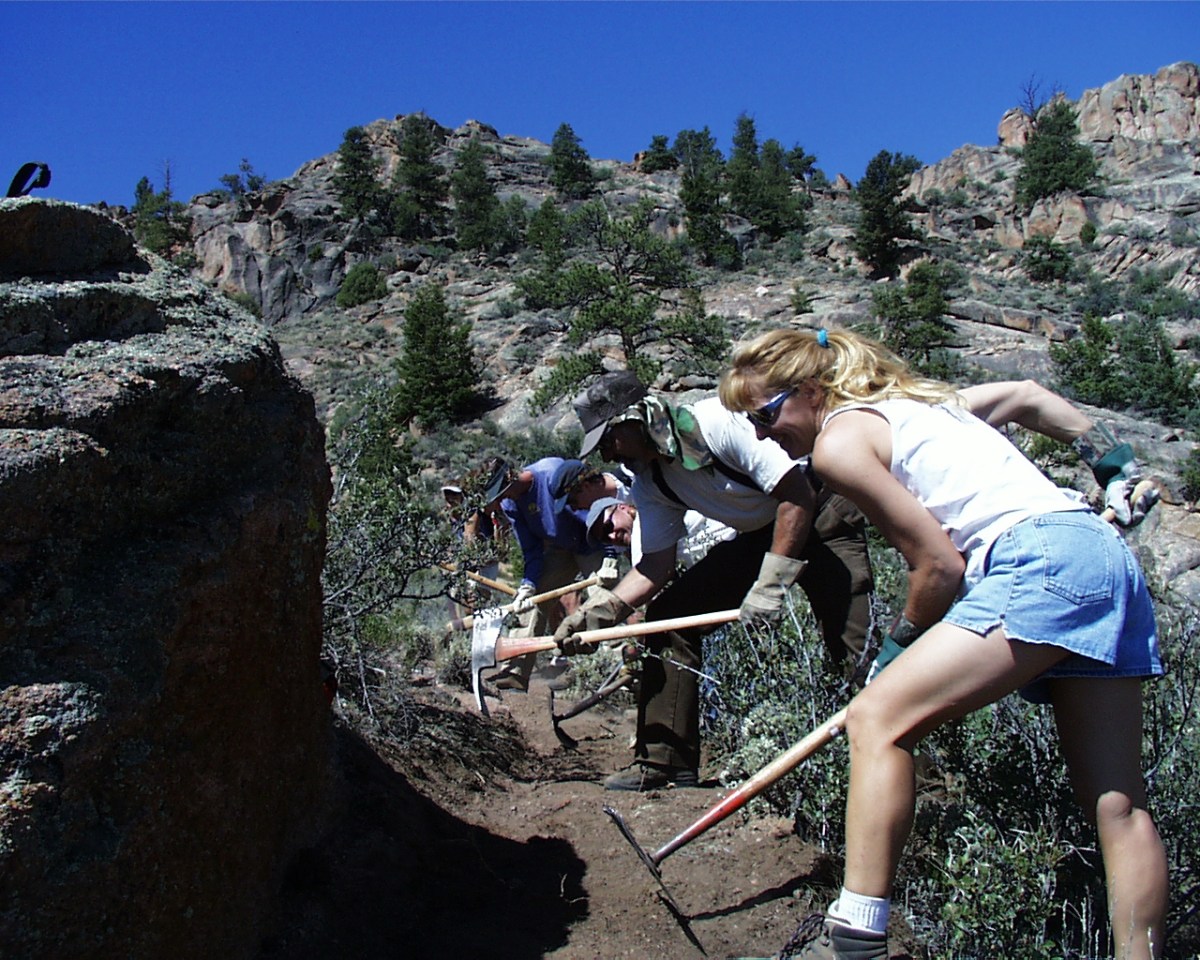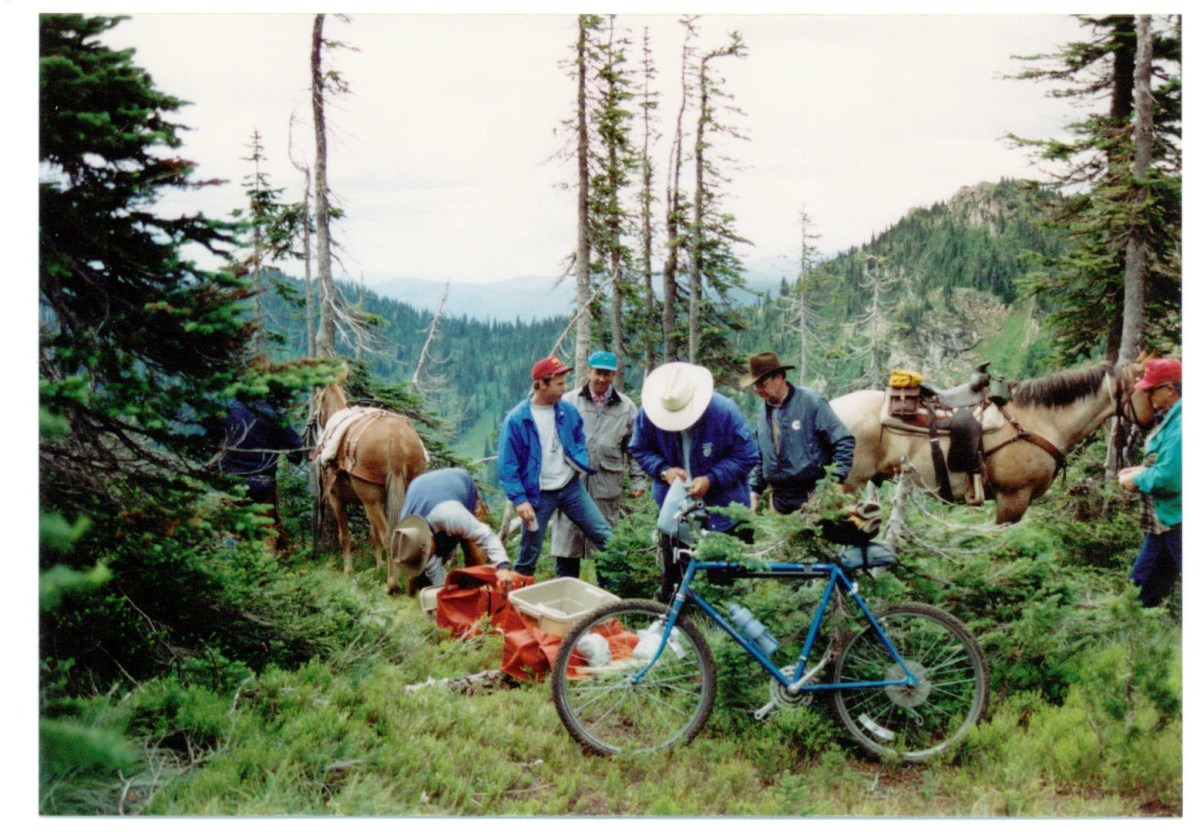There’s a new trail in a spot I like to ride that winds up switchbacks through tall Jeffrey pines to a lookout. It replaces a steep, eroded elevator shaft that was a nemesis to all mountain bikers and hikers. Now, on the new trail, the dirt is fresh and smooth. The berms are perfectly elevated and balanced. The rock gardens are clean and passable with a quick sprint. A signpost marks the entrance to the new, multiuse trail with a list of 50-plus names.
“If you bump into any of the above volunteers, consider buying them a beverage,” the signpost says.
This trail, like every trail, is something special. It’s a vision completed, the culmination of hundreds of hours logged by volunteers with shovels in hand and topographic maps on the table.
It also required collaboration between mountain bikers and the stewards of public land, in this case, the local mountain bike group and the U.S. Forest Service.
Mountain bikers built this trail, but it’s not exclusively a mountain bike trail, per se. It’s also for runners and hikers. The best part: This trail is free for everyone to use as they please.
“Every trail has a backstory. Somebody had the vision and found the money and got the permission and talked the land manager into it and built the political will,” said Ashley Korenblat, a resident of Moab, Utah, who has spent her adult life working in mountain biking, public lands and trail advocacy. In the 1990s, when she was the president of a bicycle manufacturing company in Massachusetts, Korenblat became the chair of the International Mountain Bicycling Association (IMBA)—a nationwide nonprofit that has played a fundamental role in the backstory behind more than a thousand trails across the United States.
This year, IMBA is celebrating its 30th anniversary. Mountain biking looks a lot different in 2018 than it did in 1988. For one, there are more trails to ride on, and IMBA deserves a lot of that credit. Just last year, IMBA’s Trail Solutions team helped with education, planning, design and trail building for 35 projects located in 18 states and in Mexico, totaling nearly 800 miles of trails.
IMBA has 30 years of trail-building experience, “from concept to construction,” said David Wiens, IMBA’s executive director. The group is hardly finished with its work. “IMBA is focused on creating more great trails for people to ride across the country, more great trails closer to where people live,” Wiens said. “We can be a catalyst for trail development. We can jump-start trail projects and show people the process.”

A group of volunteers builds a new trail in the early ’90s. (Photo Credit: IMBA)
IMBA was born out of a need for access. The group started in 1988 in California, when five local mountain bike groups from across the state sat down at one table. Mountain biking was fast growing from a fringe sport of the misfits to a popular sport of the mainstream, especially as gear became lighter and more available. A broader group was needed to speak on behalf of the mountain bike community at large and represent the constituency before land management groups. That first year, their conversations began with the California State Parks, which was considering banning mountain bikes on some of the state’s most popular trails.
“In every place we have access, it was because we proved we were valuable,” said Korenblat, who joined the organization’s board two years later, in 1990. “We helped with maintenance, and we helped build trails. We painted picnic tables and we bought signs and raised money and we basically went to the land managers and said, ‘What can we do to help?’”

The founding meeting of IMBA in 1988 in California. (Photo Credit: IMBA)
Soon after IMBA was founded, it published a manifesto—Six Rules of the Trail—to educate mountain bikers on etiquette and how to be good stewards of the sport. The rules told mountain bikers to respect trail and road closures, to leave no trace, to ride in control and yield to others, to never scare animals—especially horses—and to plan and be prepared for the ride ahead. It seems like common sense now, but in 1988, land managers throughout the United States and abroad started posting this code of ethics at trailhead signs and in trail brochures. Over the next two years, IMBA distributed its six rules of the trail to more than 1 million people.
Those early, formative years also set the tone for key relationships that IMBA upholds today, like the ones it shares with the Bureau of Land Management and the U.S. Forest Service. In 2000, Korenblat met with President Bill Clinton to discuss mountain bike-friendly rules in national monuments. “There had to be a conversation with the government at every level,” she said. More recently, in 2016, IMBA helped pass the National Forest System Trails Stewardship Act, which addresses the trail maintenance backlog in national forests and makes it easier for volunteers to help fill the gap. Last year, when the Department of the Interior announced a review of millions of acres of national monuments, IMBA also rallied mountain bikers and sent in 5,000 letters for public comment.
IMBA also started building relationships with other user groups—like hikers and environmentalists—in the outdoor industry. In 1993, REI became a big supporter and advocate of the IMBA, establishing a relationship that continues today. The following year, Korenblat recalls that REI hosted a conference between IMBA and the Sierra Club. At the meeting, the two groups reached a landmark agreement that recognized mountain bikers as a legitimate form of recreation and trail use.
“REI’s philanthropy is really focused on supporting organizations that increase access or infrastructure for outdoor recreation,” says Taldi Walter, REI’s community and government affairs manager. Walter has also been a board member for IMBA for the last three years. “IMBA really hits that sweet spot because they are creating the on-the-ground outdoor infrastructure, like trails, and making mountain biking more accessible for all.”

IMBA believes in trails for all—bikers, hikers and equestrians. (Photo Credit: IMBA)
This fall, IMBA is throwing a party to celebrate its 30th anniversary. Joining forces with Outerbike (a bike demo for the public), they’re going to Bentonville, Arkansas, where an explosion of trails has rejuvenated the economy. The town embraces bicycle riding and represents a future that IMBA continues to strive for. Also, the mountain bike trails in Bentonville are pretty fun to ride.
“Mountain biking, that experience, is about the trail,” Wiens said. “It’s not about the destination, the waterfall or bagging that peak, we’re out there for the ride.”
Do you want to give back to the mountain biking community? There are many ways to get involved locally.
- Look up the IMBA chapter or a mountain bike group in your community.
- See what’s going on in your area for events or volunteer days with trail building. These groups are mostly volunteer-run and are always looking for extra hands.
- If there’s something you’re looking for and don’t see—a women’s bike clinic, for example—start one yourself.
- Stop by your local bike shop or REI and use them as a resource to learn about trails and events. I found the new trail described at the beginning of this article through a recommendation from a shop clerk when I was buying a new pair of mountain bike gloves.
- Say “thank you.” When you see fellow mountain bikers with shovels in hand on the trail, give them a high five. Or buy them a beer.
